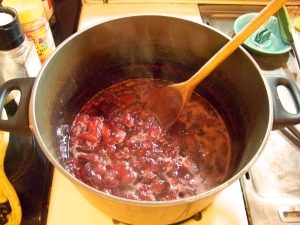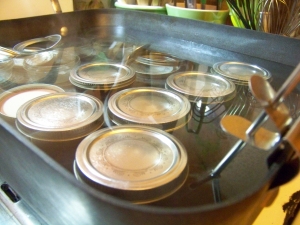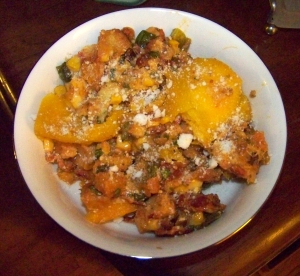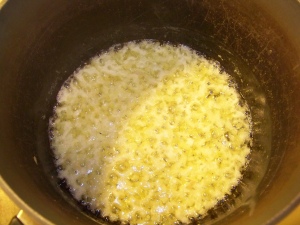
M-m-m-m-m m-m-m-m-m good.
It all started with a bag marked Dried Black Fungus (Whole).

Okay, I’m a geek. I admit it. Some people go to the beach, others go to art museums. I go to ethnic and foreign grocery stores. I’m happy to wax poetic about my experience at Carrefour in Galicia, but this one was much closer to home. It’s a market called LAX-C, and while it’s nowhere near LAX (a/k/a Los Angeles International Airport), it (like the airport) encompasses several of Los Angeles’ communities quite vibrantly. While strolling the aisles, I saw this bag of dried black fungus and just had to have it. Somebody out there clearly used this stuff, so it wouldn’t kill me, I figured. Into the shopping cart it went. I could figure out later what it really was and how it might be used.
When I got home, I discovered that it was nothing more exotic than dried wood ear mushrooms. I felt like kind of a naïf, but as luck would have it, I knew exactly how they might be deployed in a recipe.
I’ve been eating hot and sour soup for as long as I’ve been dining at Chinese restaurants, which is more than half a century. And yet, I never tried to make it myself until last night. Idiot me. Wow, this is simple. If you can operate a spoon, a knife, a pot, and a flame, you can do this. And if you have a cold, as I did when I made it, this soup beats the living tar out of chicken soup in terms of restorative powers.
NOTE: It’s easy to convert this soup to the trad non-vegan version, too. First, substitute chicken stock for vegetable stock. Then, add some shredded cooked chicken (or shredded cooked pork) at the same time you add the mushrooms, and right at the very end, beat a couple of eggs in a small bowl, and drizzle them into the soup as you stir it (that keeps them from lumping up).
If you want to keep this gluten-free, use tamari sauce rather than soy, and have a care if you are buying commercial vegetable broth that it doesn’t contain any grains that have gluten. Chances are, if it’s gluten-free, it will say so somewhere on the package.
INGREDIENTS
-
2.5 oz. / 70 g package dried Chinese fungi, such as wood ears or cloud ears
6 oz. / 170 g sliced fresh shiitake mushrooms
8 oz. / 225 g canned bamboo shoots, sliced
1-inch piece fresh ginger, peeled and grated
1 tablespoon / 20 g red chile paste, such as sambal oelek
1/4 cup / 60 ml soy sauce (or tamari sauce if you want to keep it gluten free)
1/4 cup / 60 ml rice vinegar
1 teaspoon / 6 g salt
1.5 teaspoons / 3 g ground white pepper
1/2 teaspoon / 2.5 ml sesame oil
8 cups / 1.89 liters vegetable stock
8 oz. / 225 g firm tofu, drained and sliced in 1/2-inch cubes
2 tablespoons / 16 g potato starch mixed with 1/4 cup / 60 ml water (you may also use cornstarch)
4-6 green onions, chopped, for garnish

Soaking your fungi.
DIRECTIONS
Place the dried fungus into a bowl and cover with 4 cups / 1 liter boiling water. They should soften in about 20 minutes to half an hour. Squeeze them out into the bowl and place them on a chopping board. Reserve the liquid (it goes in the pot later).

Toss out the nasty tough bits.
Slice up the fungus into spoon-size bits. You will find that the “stem” (pictured above) is particularly tough, so cut it out and discard it. It may be white, or it may not, but you will be able to tell with your fingers that it’s not been rehydrated. (It was only the very center of those two mushrooms that I tossed; there was still a fair amount of useable fungus.)
Strain the remaining juice into a heavy soup pot or dutch oven (don’t want any mushroom grit). I had 3 cups / 700 ml mushroom water, so the remaining 5 cups / 1.1 liters of liquid came from vegetable stock, and I put that on a fairly high heat to bring it to a boil. You can add the mushrooms (both kinds) at this time.
Drain the sliced bamboo shoots and slice to matchstick width (I cut mine in thirds lengthwise), and add to broth. Grate the ginger into the pot (a microplane works well for this if you have one), or grate over cutting board with box grater and add to pot.
Add chili paste, soy/tamari sauce, sesame oil, salt, and rice vinegar to soup. Stir. Add white pepper 1/2 tsp. / 1 g at a time, and taste; I like it hot, but you may want to stop at 1 tsp. 2 g if you are not a heat freak. If soup is boiling, back it off to a simmer. At the 15 minute mark of so, add the drained and cubed tofu.
In a separate bowl, whisk 2 tablespoons / 16 g potato starch with 1/4 cup / 60 ml cold water to make a slurry. Transfer slurry to pot, stirring soup with whisk as you do to prevent clumps from forming. Cook a further 10 minutes and allow to thicken. Add chopped green onions and serve. Serves 4-6.
NOTE: The process can be speeded up dramatically if you do your mise en place ahead of time. Basically, you need to have the mushrooms and the bamboo shoots in the hot broth for about 10 minutes to sofeten them up, and you need a further few minutes to allow the potato starch slurry to thicken the soup. If you use a cornstarch slurry to thicken the broth, it needs a little time to cook off the pasty taste. That’s why I like potato starch.
Also, the “hot” is coming from the white pepper and the “sour” is coming from the vinegar, so those are the two variables you’ll want to control most carefully to achieve the balance you want. You may want to add each of those a bit at a time, tasting as you go.










































